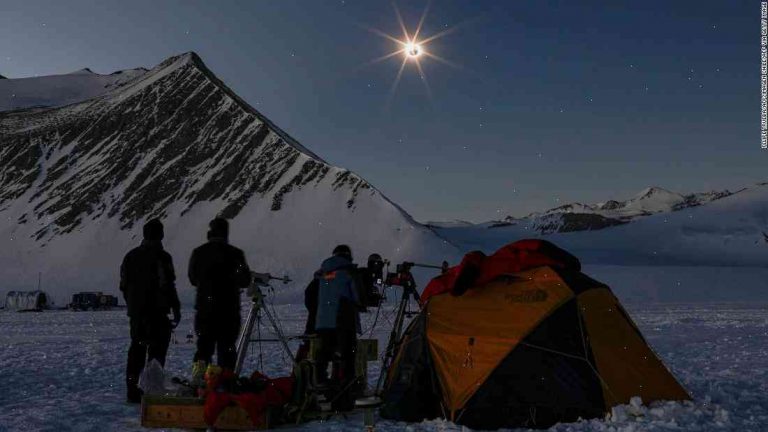See total solar eclipse over Antarctica Watch the full solar eclipse over Antarctica on 24 March
Prof Allan Young contributed to a much more colourful video
The total solar eclipse over Antarctica will be the first time a total eclipse has occurred in the region, but people in South Africa may have seen it with their own eyes. In 2010, a total eclipse was visible as far north as Cape Town, with clouds obscuring what would have been one of the rarest events in history. BBC News science editor Dr Asha Tope, who has been taking special precautions with her condition, will join Prof Allan Young, from Norwich University of Technology and Dr Nick Lovgren from Norfolk and Norwich University Hospitals NHS Foundation Trust, to give their professional view of what they have seen.
Eclipse history and science Wednesday 21st March 1759 Total eclipse from America to Australia. The eclipse is depicted by Anglo-Saxon artist William Kent. 1831 An east coast of Newfoundland – Canada – weather observatory observes an eclipse. April 23, 1697 A total eclipse over Britain. This is seen from Devon in southern England. March 15, 1683 An eclipse near Glasgow. March 21, 1851 A total eclipse over Cornwall, England. March 21, 1878 An eclipse over Northumberland. The people’s choice? Earth to plane
Picture gallery Want to see the solar eclipse, without ever stepping outside? You can watch a virtual meteor shower safely, according to astronomer Dr Scott Morgan from Royal Observatory Greenwich. Watch Solar Eclipse Cam With the peak eclipse due to come out on Wednesday at 1710GMT, Solar Eclipse Cam’s live streamed edition was released in the run-up. Dr Scott Morgan told BBC News it was the only time when solar eclipses were actually visible from Earth. Instead of being concentrated during the total eclipse phase, the phenomenon is seen in its usual, lesser, stages which are classified as annular (when the moon passes slightly to the left of the sun) or umbral (when the moon completely blocks the sun). The stationary shadow of the moon creates the corona, on which are gathered dozens of, sometimes hundreds of thousands of tiny stars from which the solar system was created. These celestial objects glow in an eerie blue-green light, still reflecting in sunlight.
2018 Solar Eclipse
Earlier: Total solar eclipse over South Africa Tope will be accompanied by Dr Martin Findham from Cambridge University who will be taken in a cloudless sky at Dundee University, the usual location for the site of the eclipse in southern Antarctica. Students were keen to get involved and organised this unusual study, informed Dr Findham. This is the first time the Nasa-sponsored instrument has taken measurements over Antarctica. He says the entire eclipse is visible from the centre of the continent, with those over the north-east coast of South Africa able to see the beginning and the middle stages of the eclipsed sun. Dr Martin Findham
‘It started with the scales’ The centre of the sun will remain completely dark, so the experience should be noticeable, but far from uncomfortable. “We think it’s going to be reasonably easy to watch the solar eclipse without any glasses on,” Dr Findham told BBC News. “The view should be great, particularly in central Antarctica, where it’ll be absolutely completely dark, and I suspect some people will come very late at night, as it’ll be freezing cold out there.” But while the journey to Scotland is relatively short, the journey back across the southern Antarctic is long. On arrival at Dundee the Sun and Moon will be in some gravitational relation, because there will be a significant return tilt in the Earth’s axis, says Dr Findham. “If you look at the direct eclipse in itself, it’ll be quite peaceful.” But a return tilt means that, when the Moon directly moves against the Sun, the Moon’s shadow will obscure a patch of the sun’s surface in the centre of Antarctica for 60 seconds. The total eclipse lasts for two minutes and 40 seconds, and is best seen from the extreme north east tip of the continent. Although the trek to Scotland will be anything but a stroll in the park, the experience of witnessing a total eclipse will have endured no small comfort, particularly for people who have been deprived of experiencing the phenomenon because it’s so rare. Dr Martin Findham
Read our review of Solar Eclipse Cam for 2018 1,200 years later, complete with a bevy of supermodels, the madness of a Madonna-and-her-lover finale will be seen by a global TV audience of billions, and an estimated 350 million people – including 2,000 schoolchildren – will watch the event live online. The double effect is a culmination of many centuries of research into human perception and eclipse. Those present on the planet in its totality will see no haze or eclipse colours, as there will be no sky darkened by the Earth. Instead, the Sun’s brightness will be reflected across the Earth’s atmosphere,
